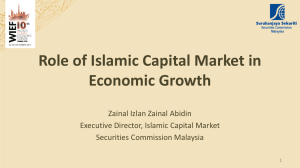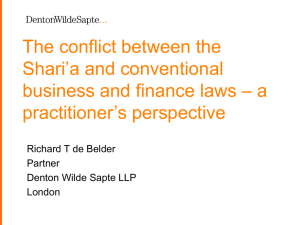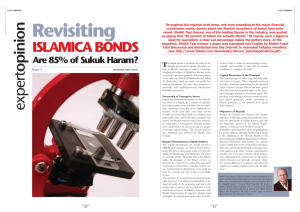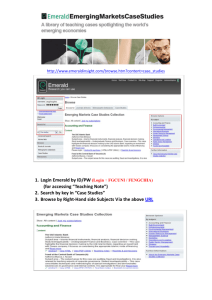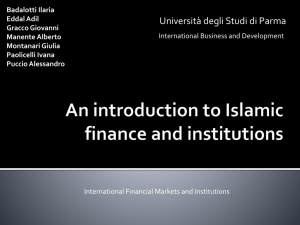Recommended Text and Readings
advertisement
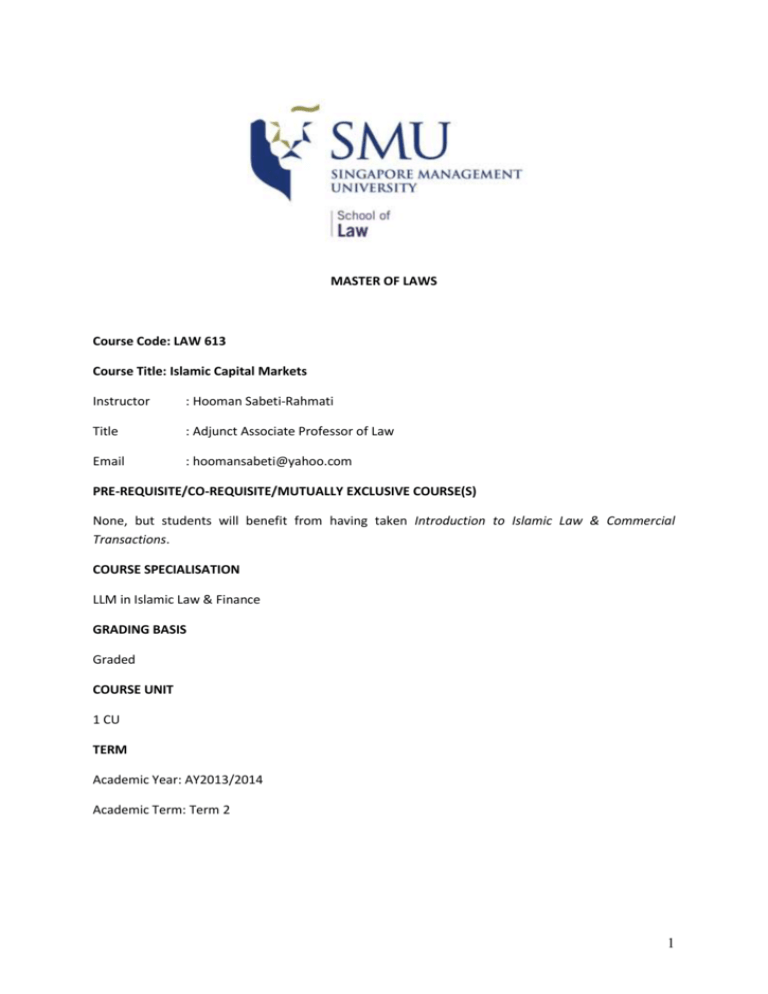
MASTER OF LAWS Course Code: LAW 613 Course Title: Islamic Capital Markets Instructor : Hooman Sabeti-Rahmati Title : Adjunct Associate Professor of Law Email : hoomansabeti@yahoo.com PRE-REQUISITE/CO-REQUISITE/MUTUALLY EXCLUSIVE COURSE(S) None, but students will benefit from having taken Introduction to Islamic Law & Commercial Transactions. COURSE SPECIALISATION LLM in Islamic Law & Finance GRADING BASIS Graded COURSE UNIT 1 CU TERM Academic Year: AY2013/2014 Academic Term: Term 2 1 COURSE DESCRIPTION This course introduces Islamic capital markets and focuses on its most significant component, sukuk, with the aim of providing a practical, working understanding. The principal products and instruments, namely sukuk, shares, REIT units, money market instruments and derivatives, will be covered. The roles of principal parties will be considered, including issuers, underwriters, investors, Shari’a advisors and bodies, lawyers, accountants, trustees, agents, rating agencies and regulators. To convey the legal, regulatory and Shari’a framework, the course will discuss domestic law, the choice of English/New York law in cross-border transactions, domestic and international securities regulation and regulators, disclosure regimes, stock exchanges, Shari’a standards bodies (eg, AAOIFI and IFSB) and Shari’a boards. The range of existing sukuk structures and their legal documentation will be considered in detail. These include ijara, istisna, musharaka, mudaraba, manfa’a and wakala structures. The few existing Shari’a-compliant true securitisation transactions will also be examined. In doing so, the course aims to provide a grasp of how to structure, negotiate, document and execute a sophisticated cross-border sukuk transaction. LEARNING OBJECTIVES By the end of this course, students should be able to understand the following from the perspective of a market participant: the purpose and role of the capital markets generally; the principal capital markets products and instruments; the parties involved, their roles, interactions and motivations; the legal, regulatory and Shari’a background; the differences between domestic and international capital markets; the differences and similarities between Islamic and conventional capital markets; structuring, documenting, negotiating and executing sukuk; and the principal legal, commercial and Shari’a constraints and how to work within them. 2 RECOMMENDED TEXT AND READINGS This course will have a practical focus and therefore involve a close examination of legal documentation for particular transactions, which will be distributed in advance of class. Reading material of a general nature will include excerpts of the following, assigned in advance of class sessions: Salman Syed Ali, Islamic Capital Markets: Products, Regulation and Development, Islamic Research and Training Institute, 2008. Chapter 3, Sukuk Market: Innovations and Challenges Chapter 12, Investment in Stocks: A Critical Review of Dow Jones Shariah Screening Norms Chapter 18, Developing Capital Markets in Muslim Countries: Strategies and Policies for Securities Regulation and Corporate Governance Chapter 20, Comparing The Development of Islamic Financial/Bond Markets in Malaysia and Indonesia Kabir Hassan and Michael Mahlknecht, Islamic Capital Markets: Products and Strategies, John Wiley & Sons, 2011. Chapter 2, The Shariah Process in Product Development and Approval in ICM Chapter 8, Overcoming Incentive Problems in Securitization: Islamic Structured Finance Chapter 11, Building up an Islamic Capital Market: The Malaysian Example Chapter 17, The Current Financial Market Crisis: Lessons Learned, Risks and Strengths of Islamic Capital Markets Compared to the Conventional System Chapter 18, An Islamic Perspective of Financial Engineering Chapter 19, Shariah-compliant Portfolio Management: Processes, Methodologies, and Performances Accounting and Auditing Organization for Islamic Financial Institutions (AAOIFI), Shari’a Standards, 2010. IIFM Sukuk Report: A Comprehensive study of the Global Sukuk Market, 3rd Edition, 2013. Dubai International Financial Center, DIFC Sukuk Guidebook, 2009 (available online at www.difc.ae). Transaction legal contracts, prospectuses, legal opinions and fatawa ASSESSMENT METHOD Class participation: 20% Group assignment: 30% Individual research paper: 50% No examination will be required. INSTRUCTIONAL METHODS AND EXPECTATIONS This is a seminar in which classroom discussion and questions will be an important part of learning. Therefore, each student is expected to have read and thought about the assigned material in advance, and to be prepared to discuss it and raise questions. Careful thinking and creative problem solving are valuable traits in this area of law, and students will have an opportunity to develop and 3 demonstrate these. For purposes of assessment, thoughtfulness rather than frequency of class participation counts. Important: Academic Integrity All acts of academic dishonesty (including, but not limited to, plagiarism, cheating, fabrication, facilitation of acts of academic dishonesty by others, unauthorized possession of exam questions, or tampering with the academic work of other students) are serious offences. All work (whether oral or written) submitted for purposes of assessment must be the student’s own work. Penalties for violation of the policy range from zero marks for the component assessment to expulsion, depending on the nature of the offence. When in doubt, students should consult the instructor of the course. Details on the SMU Code of Academic Integrity may be accessed at http://www.smuscd.org/resources.html. 4 COURSE SCHEDULE The relative amount of time we spend on the various subjects outlined below will be a function of the level of familiarity students bring to class. If students have limited capital markets background, we are likely to spend more time on foundational aspects of capital markets. Session Description 1. Overview of capital markets, their history and development, the participants and roles, the various component markets and current instruments and products 2. Legal, regulatory and Shari’a framework of Islamic capital markets, both domestic and international 3. Sukuk: basic principles and existing structures 4. Sukuk: structuring considerations and legal arrangements 5. Sukuk: negotiation, documentation and execution of transactions, including contracts, disclosure documents and legal opinions 6. Sukuk: when things go wrong - legal challenges, default and restructuring 7. Securitisation: basic principles, challenges, documentation and existing transactions 8. Money and interbank markets: existing instruments, challenges and opportunities 9. Shari’a-compliant shares 10. Course summary, directions of future development and the characteristics of capable Islamic capital markets practitioners Session 1-3 4-7 8-9 10 Description Overview of capital markets, their history and development, the participants and roles, the various component markets and current instruments and products Legal, regulatory and Shari’a framework of Islamic capital markets, both domestic and international Sukuk: basic principles and existing structures structuring considerations and legal arrangements negotiation, documentation and execution of transactions, including contracts, disclosure documents and legal opinions when things go wrong - legal challenges, default and restructuring Securitisation: basic principles, challenges, documentation and existing transactions Money and interbank markets: existing instruments, challenges and opportunities Shari’a-compliant shares Presentation of group projects Course summary Directions of future development Characteristics of capable Islamic capital markets practitioners 5


